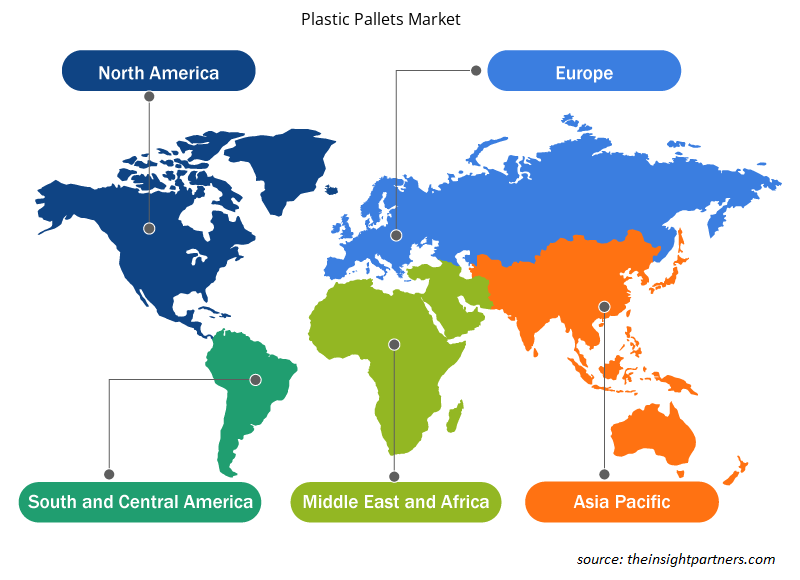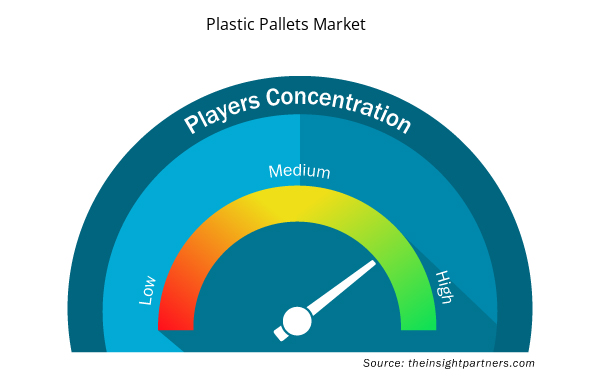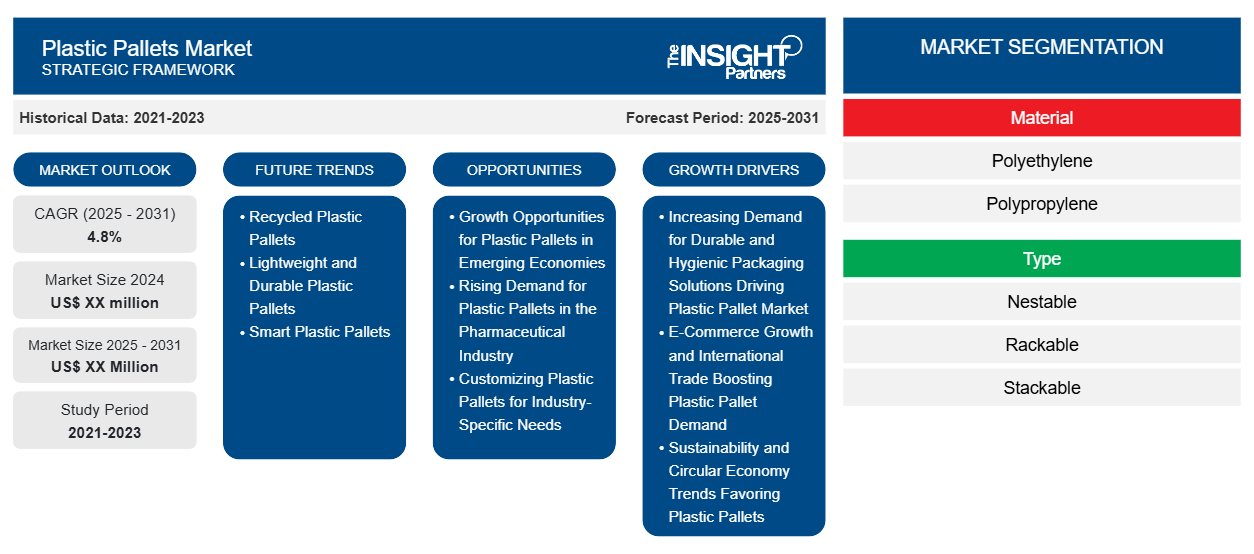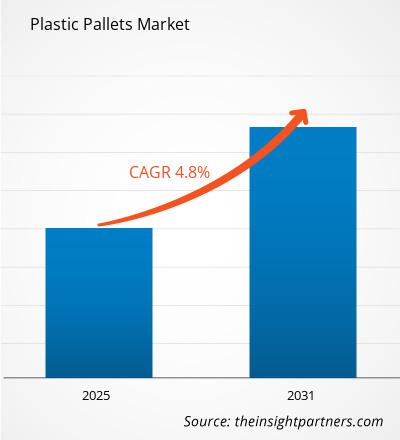Es wird erwartet, dass der Markt für Kunststoffpaletten von 2023 bis 2031 eine durchschnittliche jährliche Wachstumsrate (CAGR) von 4,8 % verzeichnet, wobei die Marktgröße von XX Millionen US-Dollar im Jahr 2023 auf XX Millionen US-Dollar im Jahr 2031 anwachsen wird.
Der Bericht ist nach Material (Polyethylen, Polypropylen und andere) segmentiert. Der Bericht ist weiter nach Typ segmentiert (schachtelbar, stapelbar und andere). Der Bericht ist nach Endverbrauch segmentiert (Lebensmittel und Getränke, Chemikalien, Erdöl und Schmierstoffe, Pharmazeutika, Automobil, Bauwesen, Einzelhandel und andere). Der Berichtsumfang umfasst fünf Regionen: Nordamerika, Europa, Asien-Pazifik, Naher Osten und Afrika sowie Süd- und Mittelamerika und Schlüsselländer in jeder Region. Die globale Analyse ist weiter auf regionaler Ebene und in den wichtigsten Ländern aufgeschlüsselt. Der Bericht bietet den Wert in USD für die oben genannte Analyse und Segmente.
Zweck des Berichts
Der Bericht „Markt für Kunststoffpaletten“ von The Insight Partners soll die aktuelle Situation und das zukünftige Wachstum sowie die wichtigsten treibenden Faktoren, Herausforderungen und Chancen beschreiben. Dies wird verschiedenen Geschäftspartnern Einblicke geben, wie zum Beispiel:
- Technologieanbieter/-hersteller: Um die sich entwickelnde Marktdynamik zu verstehen und die potenziellen Wachstumschancen zu kennen, damit sie fundierte strategische Entscheidungen treffen können.
- Investoren: Durchführung einer umfassenden Trendanalyse hinsichtlich der Marktwachstumsrate, der finanziellen Marktprognosen und der Chancen entlang der Wertschöpfungskette.
- Regulierungsbehörden: Zur Regulierung von Richtlinien und Überwachungsaktivitäten auf dem Markt mit dem Ziel, Missbrauch zu minimieren, das Vertrauen der Anleger zu bewahren und die Integrität und Stabilität des Marktes aufrechtzuerhalten.
Marktsegmentierung für Kunststoffpaletten
Material
- Polyethylen
- Polypropylen
Typ
- Nestbar
- Rackfähig
- Stapelbar
Endverbrauch
- Essen und Trinken
- Chemikalien
- Erdöl und Schmierstoffe
- Pharmazeutika
- Automobilindustrie
- Konstruktion
- Einzelhandel
Geographie
- Nordamerika
- Europa
- Asien-Pazifik
- Süd- und Mittelamerika
- Naher Osten und Afrika
Geographie
- Nordamerika
- Europa
- Asien-Pazifik
- Süd- und Mittelamerika
- Naher Osten und Afrika
Passen Sie diesen Bericht Ihren Anforderungen an
Sie erhalten kostenlos individuelle Anpassungen an jedem Bericht, einschließlich Teilen dieses Berichts oder einer Analyse auf Länderebene, eines Excel-Datenpakets sowie tolle Angebote und Rabatte für Start-ups und Universitäten.
- Holen Sie sich die wichtigsten Markttrends aus diesem Bericht.Dieses KOSTENLOSE Beispiel umfasst eine Datenanalyse von Markttrends bis hin zu Schätzungen und Prognosen.
Wachstumstreiber auf dem Markt für Kunststoffpaletten
- Steigende Nachfrage nach langlebigen und hygienischen Verpackungslösungen treibt den Markt für Kunststoffpaletten an: Eine weltweit steigende Nachfrage nach starken, leichten und effizienten Verpackungslösungen in den Bereichen Lebensmittel und Getränke, Pharmazeutika, Chemikalien und Logistik ist ein wichtiger Treiber dieses Marktes für Kunststoffpaletten. Kunststoffpaletten haben gegenüber Holz einen Vorteil, da sie langlebig, feuchtigkeits- und chemikalienbeständig und immun gegen Insekten sind. Sie lassen sich leichter reinigen und desinfizieren. Diese Anwendungen sind von Natur aus hygienischer, ähnlich wie Verpackungen, die in der Lebensmittelverarbeitung und Pharmaindustrie verwendet werden. Eine weitere Komplexität in der Lieferkette wird in direktem Zusammenhang mit der Nachfrage nach sicheren, wiederverwendbaren und effizienten Verpackungen stehen.
- Wachstum im E-Commerce und internationaler Handel steigern Nachfrage nach Kunststoffpaletten: E-Commerce und internationaler Handel verzeichnen ein explosives Wachstum, wodurch eine erhebliche Nachfrage nach Paletten aus Kunststoff entsteht. Im Zuge des Booms im Online-Shopping, in der Logistik und bei Lagerdienstleistungen suchen Unternehmen nach Verpackungsmaterialien, die Transport und Lagerung rationalisieren können. Kunststoffe sind eine gute Wahl, da sie eine einfache Handhabung bieten: Sie sind leicht, stapelbar und langlebig; sie sorgen für einen reibungslosen Handhabungsprozess, senken die Versandkosten und tragen zur Optimierung der Lagerverwaltung bei. Angesichts einer so neuen Ausrichtung, die direkt auf die Verbraucher und die Ausweitung des internationalen Handels abzielt, muss die Verpackung außerdem robust genug sein, um den Transport über lange Strecken zu überstehen. Die Nachfrage nach Kunststoffpaletten hat in Branchen wie Kunststoffen, Verpackungen und Paketen zugenommen; sie sind gefragt, weil sie nachhaltige, kostengünstige und leistungsstarke Verpackungen bieten.
- Nachhaltigkeits- und Kreislaufwirtschaftstrends begünstigen Kunststoffpaletten: Die Verwendung von Kunststoffpaletten wird zunehmend durch Umweltvorschriften und Nachhaltigkeitsanforderungen bestimmt. Die Kunststoffpalette ist recycelbar, wiederverwendbar und kann aus recyceltem Kunststoff hergestellt werden; die Verwendung von Holzpaletten führt jedoch zum Fällen von Bäumen. Der Markt für Kunststoffpaletten profitiert von der gestiegenen Nachfrage nach diesen umweltfreundlichen Alternativen, da Unternehmen und Regierungen kontinuierlich nachhaltigere Praktiken vorantreiben und die Abhängigkeit von Holzwerkstoffen verringern. Viele Branchen übernehmen Kreislaufwirtschaftsmodelle, und Kunststoffpaletten sind aufgrund ihrer langen Lebensdauer und ihrer Recyclingfähigkeit gut aufgestellt, um diese Anforderungen zu erfüllen.
Zukünftige Trends auf dem Markt für Kunststoffpaletten
- Paletten aus recyceltem Kunststoff: Die Verwendung von recyceltem Kunststoff ist heute ein starker Trend auf dem globalen Markt für Kunststoffpaletten. Der Trend geht dahin, recycelten Kunststoff (PCR) wie recyceltes PET (rPET) zu verwenden und Paletten herzustellen, die sowohl ökologische als auch funktionale Anforderungen erfüllen. Die treibenden Kräfte hinter diesem Trend sind einerseits die Vorlieben der Verbraucher und andererseits die gesetzlichen Anforderungen, die zu einer Abfallreduzierung führen. Die Verwendung von recyceltem Kunststoff verringert den ökologischen Fußabdruck von Kunststoffpaletten und spart den Herstellern gleichzeitig Material. Dies wird zu einem wichtigen Differenzierungsmerkmal für Unternehmen, die nach Möglichkeiten suchen, die heute umweltbewussteren Verbraucher und Unternehmen anzusprechen.
- Leichte und langlebige Kunststoffpaletten: Verbesserung der Versandeffizienz: Nachfrage nach leichten und dennoch sehr langlebigen Kunststoffpaletten. Leichte Paletten, die stark genug sind, um eine schwere Versandlast zu tragen, aber gleichzeitig die Transportkosten senken, was heute in den Branchen insbesondere in der Logistik und im E-Commerce zu finden ist. Die Verwendung von leichten Kunststoffpaletten trägt wirksam dazu bei, den Kraftstoffverbrauch beim Versand zu senken und eine effizientere Lieferkette aufzubauen. Hersteller haben neue Materialien wie hochfeste Polymere und fortschrittliche Designs entwickelt, die die besten Eigenschaften von Leichtigkeit und Festigkeit mit wirtschaftlichen und Leistungswerten kombinieren.
- Intelligente Kunststoffpaletten: Die Verknüpfung von Technologien wie RFID-Tags und IoT-Sensoren mit Kunststoffpaletten. Diese intelligenten Paletten helfen dabei, die Waren in der gesamten Lieferkette zu verfolgen, sodass Echtzeitdaten zu Bestand, Standort und Zustand verfügbar sind. All dies verbessert die Transparenz der Integration in die Lagerprozesse und minimiert Verluste oder Diebstahl. Die Verwendung intelligenter Kunststoffpaletten nimmt mit dem Wachstum datengesteuerter Branchen zu, die Automatisierung in ihrer Lieferkette nutzen, insbesondere im Einzelhandel, der Pharmaindustrie sowie der Lebensmittel- und Getränkeindustrie.
Marktchancen für Kunststoffpaletten
- Wachstumschancen für Kunststoffpaletten in Schwellenländern: Die Schwellenländer, vor allem im asiatisch-pazifischen Raum, in Lateinamerika und Afrika, mit ihrem deutlichen Wachstum in der Industrialisierung und Urbanisierung bieten potenzielle Wachstumschancen für den Markt für Kunststoffpaletten. Mit dem rasanten Wachstum der Fertigungs-, E-Commerce- und Einzelhandelssektoren steigt die Nachfrage nach effizienten und langlebigen Verpackungslösungen. Die Nachfrage nach einer besseren Lieferketteninfrastruktur und einem sichereren Warentransport ist einer der Hauptgründe für die zunehmende Verwendung von Kunststoffpaletten in diesen Märkten. Hersteller können diese Chancen nutzen, indem sie ihre Produktionskapazität ausbauen, lokale Partnerschaften eingehen und kostengünstige, nachhaltige Alternativen zu Holzpaletten finden.
- Steigende Nachfrage nach Kunststoffpaletten in der Pharmaindustrie: Der Markt für Kunststoffpaletten wird erhebliche Verkaufschancen aus der Pharmaindustrie erfahren, da die Anforderungen an Lieferkette und Produktintegrität in den kommenden Jahren deutlich strenger werden. Pharmazeutische Produkte, insbesondere solche, die gekühlt werden müssen und sorgfältig gehandhabt werden müssen, erfordern Verpackungen, die hygienische, robuste und sichere Anforderungen erfüllen müssen. Bei Kunststoffpaletten wird dies erreicht, da sie Feuchtigkeit, Chemikalien und Verunreinigungen abweisen. Im Vergleich zu Holzpaletten können Kunststoffpaletten leicht sterilisiert werden. Mit dem Wachstum der globalen Märkte für Pharmazeutika, insbesondere in den Schwellenmärkten, werden Kunststoffpaletten in der Arzneimittelverteilung und -lagerung immer beliebter.
- Anpassen von Kunststoffpaletten an branchenspezifische Anforderungen: Steigende Nachfrage nach kundenspezifischen Kunststoffpaletten, die auf die spezifischen Anforderungen einer Branche oder Anwendung zugeschnitten sind. Heute produzieren die Hersteller Paletten in unterschiedlichen Größen, Farben und Konfigurationen, um den unterschiedlichen Geschäftsanforderungen je nach Größe bei Automobilherstellern, Einzelhändlern, der Lebensmittel- und Getränkeindustrie und anderen Branchen gerecht zu werden. Dies kann durch hochbelastbare Kanten, mehr Unterstützung für übergroße Lasten oder eine höhere Stapelkapazität geschehen. Angesichts der guten Wachstumsaussichten besteht Spielraum für Wachstum, indem kundenspezifische Kunststoffpalettendesigns speziell für die spezifischen Anforderungen einer Branche entwickelt werden, während heute mehr Unternehmen nach Platz, besserer Nutzung und verbesserter Effizienz mit kostensenkenden Lösungen suchen.
Regionale Einblicke in den Markt für Kunststoffpaletten
Die regionalen Trends und Faktoren, die den Markt für Kunststoffpaletten im Prognosezeitraum beeinflussen, wurden von den Analysten von Insight Partners ausführlich erläutert. In diesem Abschnitt werden auch die Marktsegmente und die Geografie von Kunststoffpaletten in Nordamerika, Europa, im asiatisch-pazifischen Raum, im Nahen Osten und Afrika sowie in Süd- und Mittelamerika erörtert.

- Holen Sie sich die regionalen Daten für den Markt für Kunststoffpaletten
Umfang des Marktberichts für Kunststoffpaletten
| Berichtsattribut | Details |
|---|---|
| Marktgröße im Jahr 2023 | XX Millionen US-Dollar |
| Marktgröße bis 2031 | XX Millionen US-Dollar |
| Globale CAGR (2023 - 2031) | 4,8 % |
| Historische Daten | 2021-2022 |
| Prognosezeitraum | 2024–2031 |
| Abgedeckte Segmente | Nach Material
|
| Abgedeckte Regionen und Länder | Nordamerika
|
| Marktführer und wichtige Unternehmensprofile |
|
Marktdichte von Kunststoffpaletten: Auswirkungen auf die Geschäftsdynamik verstehen
Der Markt für Kunststoffpaletten wächst rasant, angetrieben durch die steigende Nachfrage der Endverbraucher aufgrund von Faktoren wie sich entwickelnden Verbraucherpräferenzen, technologischen Fortschritten und einem größeren Bewusstsein für die Vorteile des Produkts. Mit steigender Nachfrage erweitern Unternehmen ihr Angebot, entwickeln Innovationen, um die Bedürfnisse der Verbraucher zu erfüllen, und nutzen neue Trends, was das Marktwachstum weiter ankurbelt.
Die Marktteilnehmerdichte bezieht sich auf die Verteilung der Firmen oder Unternehmen, die in einem bestimmten Markt oder einer bestimmten Branche tätig sind. Sie gibt an, wie viele Wettbewerber (Marktteilnehmer) in einem bestimmten Marktraum im Verhältnis zu seiner Größe oder seinem gesamten Marktwert präsent sind.
Die wichtigsten auf dem Markt für Kunststoffpaletten tätigen Unternehmen sind:
- OMNIPAK SRO
- LOSCAM
- ORBIS Corporation
- Bekuplast GmbH
- Meridian Group DOO
Haftungsausschluss : Die oben aufgeführten Unternehmen sind nicht in einer bestimmten Reihenfolge aufgeführt.

- Überblick über die wichtigsten Akteure auf dem Markt für Kunststoffpaletten
Wichtige Verkaufsargumente
- Umfassende Abdeckung: Der Bericht deckt die Analyse von Produkten, Dienstleistungen, Typen und Endbenutzern des Kunststoffpalettenmarktes umfassend ab und bietet einen ganzheitlichen Überblick.
- Expertenanalyse: Der Bericht basiert auf dem umfassenden Verständnis von Branchenexperten und Analysten.
- Aktuelle Informationen: Der Bericht stellt durch die Abdeckung aktueller Informationen und Datentrends Geschäftsrelevanz sicher.
- Anpassungsoptionen: Dieser Bericht kann angepasst werden, um spezifische Kundenanforderungen zu erfüllen und die Geschäftsstrategien optimal anzupassen.
Der Forschungsbericht zum Markt für Kunststoffpaletten kann daher dabei helfen, die Branchensituation und Wachstumsaussichten zu entschlüsseln und zu verstehen. Obwohl es einige berechtigte Bedenken geben kann, überwiegen die allgemeinen Vorteile dieses Berichts tendenziell die Nachteile.
- Historische Analyse (2 Jahre), Basisjahr, Prognose (7 Jahre) mit CAGR
- PEST- und SWOT-Analyse
- Marktgröße Wert/Volumen – Global, Regional, Land
- Branche und Wettbewerbsumfeld
- Excel-Datensatz



Report Coverage
Revenue forecast, Company Analysis, Industry landscape, Growth factors, and Trends

Segment Covered
This text is related
to segments covered.

Regional Scope
North America, Europe, Asia Pacific, Middle East & Africa, South & Central America

Country Scope
This text is related
to country scope.
Häufig gestellte Fragen
Growth in lightweight and high-strength pallets is expected to be the key market trend.
The report can be delivered in PDF/Word format, we can also share excel data sheet based on request.
On the basis of geography, the plastic pallets market is classified into North America, Europe, Asia Pacific, Middle East and Africa, and South and Central America
Duy Tan Plastic Co, MIPS Plastics, Sanko Plastics (Thailand) Co Ltd, Zhejiang Zhengji Plastic Industry Co Ltd, Mah Sing Plastics Industries Sdn Bhd, Arabian Plastics Industrial Co Ltd, Taldeen Plastic Solutions Co, OZON PALET, and IranPlast Co
The major factors driving the plastic pallets market are:
1. Increasing Demand for Efficient and Durable Packaging Solutions.
2. Rise in E-commerce and Global Trade.
The Plastic Pallets Market is estimated to witness a CAGR of 4.8% from 2023 to 2031
Trends and growth analysis reports related to Chemicals and Materials : READ MORE..
The List of Companies
1. OMNIPAK S.R.O
2. LOSCAM
3. ORBIS Corporation
4. Bekuplast GmbH
5. Meridian Group D.O.O
6. Rehrig Pacific
7. Schoeller Allibert
8. Craemer Holding GmbH
9. Falkenhahn AG
10. Kamps Pallets
The Insight Partners performs research in 4 major stages: Data Collection & Secondary Research, Primary Research, Data Analysis and Data Triangulation & Final Review.
- Data Collection and Secondary Research:
As a market research and consulting firm operating from a decade, we have published and advised several client across the globe. First step for any study will start with an assessment of currently available data and insights from existing reports. Further, historical and current market information is collected from Investor Presentations, Annual Reports, SEC Filings, etc., and other information related to company’s performance and market positioning are gathered from Paid Databases (Factiva, Hoovers, and Reuters) and various other publications available in public domain.
Several associations trade associates, technical forums, institutes, societies and organization are accessed to gain technical as well as market related insights through their publications such as research papers, blogs and press releases related to the studies are referred to get cues about the market. Further, white papers, journals, magazines, and other news articles published in last 3 years are scrutinized and analyzed to understand the current market trends.
- Primary Research:
The primarily interview analysis comprise of data obtained from industry participants interview and answers to survey questions gathered by in-house primary team.
For primary research, interviews are conducted with industry experts/CEOs/Marketing Managers/VPs/Subject Matter Experts from both demand and supply side to get a 360-degree view of the market. The primary team conducts several interviews based on the complexity of the markets to understand the various market trends and dynamics which makes research more credible and precise.
A typical research interview fulfils the following functions:
- Provides first-hand information on the market size, market trends, growth trends, competitive landscape, and outlook
- Validates and strengthens in-house secondary research findings
- Develops the analysis team’s expertise and market understanding
Primary research involves email interactions and telephone interviews for each market, category, segment, and sub-segment across geographies. The participants who typically take part in such a process include, but are not limited to:
- Industry participants: VPs, business development managers, market intelligence managers and national sales managers
- Outside experts: Valuation experts, research analysts and key opinion leaders specializing in the electronics and semiconductor industry.
Below is the breakup of our primary respondents by company, designation, and region:

Once we receive the confirmation from primary research sources or primary respondents, we finalize the base year market estimation and forecast the data as per the macroeconomic and microeconomic factors assessed during data collection.
- Data Analysis:
Once data is validated through both secondary as well as primary respondents, we finalize the market estimations by hypothesis formulation and factor analysis at regional and country level.
- Macro-Economic Factor Analysis:
We analyse macroeconomic indicators such the gross domestic product (GDP), increase in the demand for goods and services across industries, technological advancement, regional economic growth, governmental policies, the influence of COVID-19, PEST analysis, and other aspects. This analysis aids in setting benchmarks for various nations/regions and approximating market splits. Additionally, the general trend of the aforementioned components aid in determining the market's development possibilities.
- Country Level Data:
Various factors that are especially aligned to the country are taken into account to determine the market size for a certain area and country, including the presence of vendors, such as headquarters and offices, the country's GDP, demand patterns, and industry growth. To comprehend the market dynamics for the nation, a number of growth variables, inhibitors, application areas, and current market trends are researched. The aforementioned elements aid in determining the country's overall market's growth potential.
- Company Profile:
The “Table of Contents” is formulated by listing and analyzing more than 25 - 30 companies operating in the market ecosystem across geographies. However, we profile only 10 companies as a standard practice in our syndicate reports. These 10 companies comprise leading, emerging, and regional players. Nonetheless, our analysis is not restricted to the 10 listed companies, we also analyze other companies present in the market to develop a holistic view and understand the prevailing trends. The “Company Profiles” section in the report covers key facts, business description, products & services, financial information, SWOT analysis, and key developments. The financial information presented is extracted from the annual reports and official documents of the publicly listed companies. Upon collecting the information for the sections of respective companies, we verify them via various primary sources and then compile the data in respective company profiles. The company level information helps us in deriving the base number as well as in forecasting the market size.
- Developing Base Number:
Aggregation of sales statistics (2020-2022) and macro-economic factor, and other secondary and primary research insights are utilized to arrive at base number and related market shares for 2022. The data gaps are identified in this step and relevant market data is analyzed, collected from paid primary interviews or databases. On finalizing the base year market size, forecasts are developed on the basis of macro-economic, industry and market growth factors and company level analysis.
- Data Triangulation and Final Review:
The market findings and base year market size calculations are validated from supply as well as demand side. Demand side validations are based on macro-economic factor analysis and benchmarks for respective regions and countries. In case of supply side validations, revenues of major companies are estimated (in case not available) based on industry benchmark, approximate number of employees, product portfolio, and primary interviews revenues are gathered. Further revenue from target product/service segment is assessed to avoid overshooting of market statistics. In case of heavy deviations between supply and demand side values, all thes steps are repeated to achieve synchronization.
We follow an iterative model, wherein we share our research findings with Subject Matter Experts (SME’s) and Key Opinion Leaders (KOLs) until consensus view of the market is not formulated – this model negates any drastic deviation in the opinions of experts. Only validated and universally acceptable research findings are quoted in our reports.
We have important check points that we use to validate our research findings – which we call – data triangulation, where we validate the information, we generate from secondary sources with primary interviews and then we re-validate with our internal data bases and Subject matter experts. This comprehensive model enables us to deliver high quality, reliable data in shortest possible time.


 Holen Sie sich ein kostenloses Muster für diesen Bericht
Holen Sie sich ein kostenloses Muster für diesen Bericht